Developing E-Business Strategies Curriculum Case Study in the Information Systems Department
Автор: Thoria Alghamdi, Arwa Jamjoom
Журнал: International Journal of Modern Education and Computer Science (IJMECS) @ijmecs
Статья в выпуске: 2 vol.4, 2012 года.
Бесплатный доступ
E-Business Strategies (EBS) is an elective course in the Information Systems Department, Faculty of Computing & Information Technology at King Abdulaziz University, Jeddah. In this course, students learn many concepts regarding e-business, such as strategies, models, relationships and so on. Also, they improve their leadership skills, such as analyzing the business environment and take the decisions. In this paper, we address the main challenges faced by the EBS course developers and study all the components of the existing EBS course. We then determine a learning strategy using an Outcomes-based Education (OBE) approach and redesign the course using an Active Learning Approach. This paper provides comprehensive information concerning an EBS course in terms of its importance, goals, textbook and evaluation tools.
Active Learning Approach, E-business Strategies, Outcomes-based Education
Короткий адрес: https://sciup.org/15010393
IDR: 15010393
Текст научной статьи Developing E-Business Strategies Curriculum Case Study in the Information Systems Department
Published Online March 2012 in MECS DOI: 10.5815/ijmecs.2012.02.01
Higher education is affected by the community and has an affect on it. Therefore, higher education institutes continuously work on developing their curricula to ensure that their educational outcomes match their community's needs and that students are provided with the necessary knowledge and skills.
An E-Business Strategies (EBS) course is concerned with organizations in the economic world. This world changes rapidly with revolutions in communication and technology, so developing an EBS curriculum necessary in order to ensure that such curriculum always achieves the community's needs.
“The word Curriculum has the meaning of educational path and describes the learning process in a much more comprehensive and complex fashion than is possible with Plans of learning content or learning material” [1]. This definition of curriculum describes it as a comprehensive concept, not limiting it to the content that will be presented. Rather, it includes a number of elements such as the learning method and the evaluation method. These elements are integrated together to achieve the objectives of the course.
The main challenge faced by the EBS curriculum's developers is the nature of this course; specifically, students cannot test most of the EBS course's concepts in the real world and within the short course period, concepts such as choosing both a strategy and an EBusiness model. The limitation of using a special laboratory and simulation programs forces the course's developers to deal with existing learning tools such as books, multimedia and slide show. With these tools, designers face the challenge of designing an EBS course in which students can test the main concepts as they would in the real world. Thus, the developers should work on decreasing the gap between reality and theory.
In this paper we developed E-Business strategies course depends on OBE approach and applied the developed course on class of 19 students. At the end of the course we measured the achieved goals.
The paper is organized as follows; section 2 presents E-Business strategies importance. Section 3 illustrates the OBE approach which we chose to follow. The learning objectives, textbook, learning methods and evaluation methods are explain in order in sections 4-5-6-7, while the result Discussion is in section 8. At the end, section 9 includes the conclusion.
-
II. E-Business Strategy Course
This course is an elective course in the Information Systems Department at King Abdulaziz University. It is three credit hours, and it is offered to students as lectures and sections. The lectures are for discussing theory, and the sections are for conducting practical experiments.
Many educational institutions offer E-Business programs. These programs consist of a variety courses. In fact, a survey by Davis and his colleagues shows that EBS course represents major course in E-Business program lists. This survey includes 391 different EBusiness courses (52 (13.3%) undergraduate and 339 (86.7%) graduate). Of these courses, EBS course takes second place, with 12% from all the courses offered by these schools [2].
I. III. Outcomes-based Approach
The traditional way of developing modules in higher education focuses on what is being taught. This way does not fit with the view which considers the student to be the main element in the learning process.
However, an Outcomes-based Education (OBE) Approach focuses on learning rather than on teaching. Therefore, it is not centered on what the teacher can provide but on what the learner can demonstrate at the end of a module or course. Spady defines OBE as
"A method that is clearly focusing and organizing everything in an educational system around what is essential for all students to be able to do successfully at the end of their learning experiences. This means starting with a clear picture of what is important for students to be able to do, then organizing the curriculum, instruction, and assessment to make sure this learning ultimately happens." [3]
By looking to the OBE system, we come to consider both the student and the curriculum as the input, while the output is the student who has gained added value, knowledge and skills. The system will fail if the students did not achieve the objectives. If this is the case, elements of the learning system should be reviewed and changed. Fig. 1 illustrates this view.
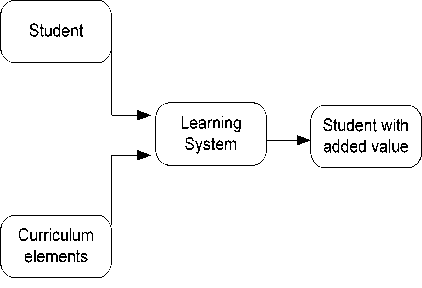
Figure 1. Representation of OBE as a system
OBE is currently the favored approach in countries such as Canada, the United States and New Zealand.
To apply OBE, we follow six steps:
Develop learning objectives and outcomes.
Select the content.
Set the plan.
Identify the teaching method.
Identify the assessment tools for the course.
Determine the evaluation method.
The objectives should be developed while keeping in mind the students’ and community's needs. The content should provide students with all information they need to achieve the objectives. The learning methods should be appropriate in regard to the type of information and skills being taught and should be able to transfer these to the students. The evaluation methods should be chosen carefully to ensure that they are able to measure the added value. Fig. 2 shows the steps for applying OBE.
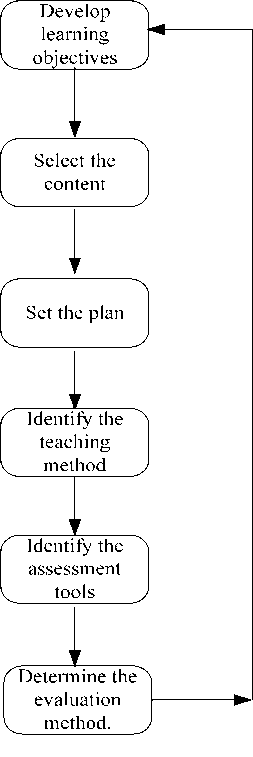
Figure 2. Steps for applying OBE
IV. Learning objectives and outcomes
The objective of this course is to provide a foundation that prepares students to be future managers, to play leading roles and to manage e-business. The knowledge that students are expected to learn is:
-
1. Define the new economy, and the Evolution of E-business.
-
2. Describe the implications of E-business.
-
3. Describe the new business environment
-
4. Relate ICT revolution and the information economy with the 'real new Economy'.
-
5. Identify the 12 new rules of the Network Economy.
-
6. Discuss the basic rules that have been changed in the business environment
-
7. Describe how the internet redefines organizational boundaries.
-
8. Illustrate the deconstruct of the integrated business model.
-
9. Identify the new strategies for the network economy.
-
10. Describe the strategy of disruption.
-
11. Illustrate the context for the strategic reorientation.
-
12. Define the current E-business model.
-
13. Illustrate the role of ICT in structural innovations.
-
14. Explain why hierarchies structure thrive.
-
15. Define business process and types of business process innovations.
-
16. Describe the virtual team, and techniques to built trust in virtual teams.
-
17. Describe the inter-organizational innovations through inter-organizational information system.
-
18. Emphasize the importance of E-business and other key areas and emerging issues.
The skills that students are expected to obtain or improve upon are analysis and planning. Students should be able to analyze the business environment, explore opportunities, face challenges, gain strength and overcome weakness in order to be able to develop ebusiness plans that depend on rational strategies.
V. THE CONTENT AND TEXTBOOK
The selected textbook, entitled What Is E-Business?: How the Internet Transforms Organizations by Feng Li, consists of three parts. The first part focuses on the new e-business environment, the second focuses on emerging strategies and business models in the network economy, and the third focuses on organizational innovations resulting from information and communications technologies [4].
In this book, the author presents the information such that many different opinions are discussed without the author adopting one specific opinion. This way of presenting information encourages the student to play a role other than merely receiving the information—it motivates the student to think and debate.
To assist in the student’s understanding, the book includes many examples of real companies. Also, it provides additional reading selections and questions at the end of each chapter to help the student enrich his/her knowledge.
Professor Michael Williams from Swansea University notes that Li’s book is appropriate for academic study, saying, “The book focuses upon the opportunities and challenges resulting from the emergence of the Internet and related technologies as a potent tool of modern business. It is therefore suitable for students at various levels of study.” [8]
Also, the editor-in-chief for the International Journal of E-Business Research, In Lee, has the same opinion regarding the appropriateness of Li’s book for academic study, saying, “This book is intended for teachers and students as well as practitioners. It provides readers with a coherent conceptual framework to integrate the vast range of topics and issues surrounding e-business with their existing knowledge and experience.” [5]
Li’s book supports decreasing the gap between academic study and real life. Professor Williams emphasizes this, noting,
Unlike many authors writing on this subject, Li shuns the need to devote large sections of the text to detailed discussions of the various technical components that make up the e-business infrastructure, preferring instead to focus upon the salient theories and conceptual frameworks relevant to modern-day organizational issues.
Lee, again, illustrates the importance of Li’s book by stating,
During the dot.com bust in the early 2000s many dot.com companies lacking a viable business model went out of business. However, the dot.com bust did not make the end of the Internet and e-business. Because of the underlying growth of the digital society and economy, the consumer has pushed e-commerce forward during the economic downturn. [5]
VI. Learning Methods and Assessment Tools
The learning method for this course is classified as following the Active Learning Approach because this approach promotes focusing on what students can do with course material instead of what instructors teach or deliver to students.
Active learning can be defined as “providing opportunities for students to meaningfully talk and listen, write, read and reflect on the content, ideas, issues and concerns of an academic subject” [6].
Choosing the proper method from a variety of active learning methods—such as lectures, discussions, presentations, problem-based learning, role play, brainstorming and case studies—depends on the nature of the subject, the number of students and the facilities available.
Two techniques were adopted. The first is that of using lectures. Sajjad designed a survey to seek students' opinion about the most effective teaching methods used by their teachers, and the reasons for highly rating. He founded that most students rated the lecture method as the best teaching method because in this method, the teacher provides all knowledge related to the topic [7]. The second technique is the case study:
The essential premise is that through knowing one instance student is better prepared to know another. The emphasis is on what often, frequently, usually or generally happens and what can be done about it. The significant variables, in a real setting, give students a feel for managing uncertainty rather than a knack at law-like prediction [8].
VII. Evaluation Method
Students are asked to work in groups to study a real company that expanded into e-business and offer a proposal of developing the company’s strategy, structure, and processes. Also, students are asked to make a presentation to share information and new ideas. This project measures the skills that students gained during their studies. Later, the final exams are designed to test all the knowledge the students have learned.
VIII. Result Discussing
To evaluate the developed E-Business course, we used tow methods. The first method was the self –rating in scale of five points A-B-C-D-F. In this method each student rates herself for each objective of the 18 objectives, which we listed before in the learning objectives. A represents the full understanding and F represents the lack of understanding. Table 1 show the result of the self-rating method. The first row contains the scale of understanding and the first column contains the objectives, the intersection cell contains the percentage of students who rate their selves for each objective. As it clear at least 50% of students rate themselves as a full understanding for all the objectives. Also, at least 83.3% of students rate themselves as understand all the objectives in scale A or B. Table 2 show the average percentage of students in each scale.
TABLE 1
THE RESULT OF SELF-RATING
|
A |
B |
C |
D |
F |
||
|
1. |
Define the new economy, and the Evolution of Ebusiness. |
83.3% |
0.00% |
0.00% |
0.00% |
16.60% |
|
2. |
Describe the implications of E-business. |
66.6% |
16.60% |
0.00% |
0.00% |
16.60% |
|
3. |
Describe the new business environment |
66.6% |
16.60% |
0.00% |
0.00% |
16.60% |
|
4. |
Relate ICT revolution and the information economy with the 'real new Economy'. |
66.6% |
16.60% |
0.00% |
0.00% |
16.60% |
|
5. |
Identify the 12 new rules of the Network Economy. |
66.6% |
16.60% |
0.00% |
0.00% |
16.60% |
|
6. |
Discuss the basic rules that have been changed in the business environment |
66.6% |
16.60% |
0.00% |
0.00% |
16.60% |
|
7. |
Describe how the internet redefines organizational boundaries |
83.3% |
0.00% |
0.00% |
0.00% |
16.60% |
|
8. |
Illustrate the deconstruct of the integrated business model. |
66.6% |
16.60% |
0.00% |
0.00% |
16.60% |
|
9. |
Identify the new strategies for the network economy. |
66.6% |
16.60% |
0.00% |
0.00% |
16.60% |
|
10. |
Describe the strategy of disruption. |
66.6% |
16.60% |
0.00% |
0.00% |
16.60% |
|
11. |
Illustrate the context for the strategic reorientation. |
83.3% |
0.00% |
0.00% |
0.00% |
16.60% |
|
12. |
Define the current E-business model. |
66.6% |
16.60% |
0.00% |
0.00% |
16.60% |
|
13. |
Illustrate the role of ICT in structural innovations. |
66.6% |
16.60% |
0.00% |
0.00% |
16.60% |
|
14. |
Explain why hierarchies structure thrive. |
66.6% |
16.60% |
0.00% |
0.00% |
16.60% |
|
15. |
Define business process and types of business process innovations. |
66.6% |
16.60% |
0.00% |
0.00% |
16.60% |
|
16. |
Describe the virtual team, and techniques to built trust in virtual teams. |
66.6% |
16.60% |
0.00% |
0.00% |
16.60% |
|
17. |
Describe the inter-organizational innovations through inter-organizational information system. |
66.6% |
16.60% |
0.00% |
0.00% |
16.60% |
|
18. |
Emphasize the importance of E-business and other key areas and emerging issues |
50.0% |
33.30% |
0.00% |
0.00% |
16.60% |
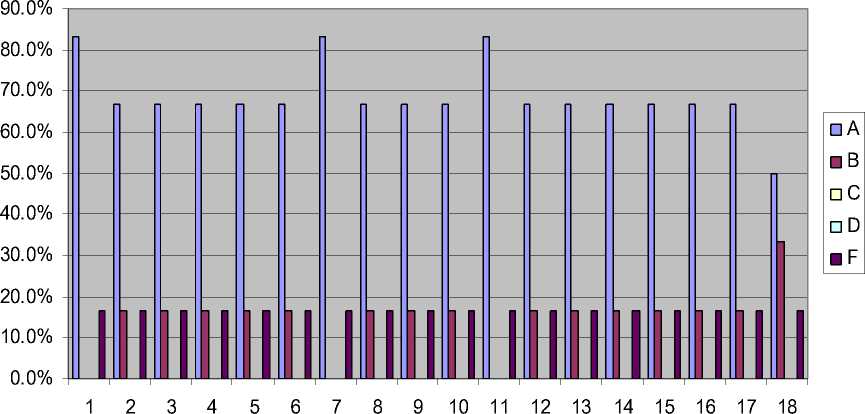
Figure 3. The result of self-rating
TABLE 2
THE AVERAGE PERCENTAGE FOR THE SELFRATING
A B C D F
68.5% 14.8% 0.0% 0.0% 16.6%

Figure 4. The average percentage for the self-rating
The second method which used to evaluate the developed E-Business course is the final exam. The final exam contains three questions and each question tests number of objectives as the following:
Q1: covers 35% of the objectives and it measures the ability to analyze a problem, and identify and define the computing requirements appropriate to its solution. It covers the following objectives:
-
1. Relate ICT revolution and the information economy with the 'real new Economy'.
-
2. Identify the 12 new rules of the Network Economy.
-
3. Discuss the basic rules that have been changed in the business environment.
-
4. Define the current E-business model.
-
5. Describe the virtual team, and techniques to built trust in virtual teams.
Q2: covers 42% of the objectives and it measures the ability to analyze the local and global impact of computing on individuals, organizations, and society. It covers the following objectives:
-
1. Define the new economy, and the Evolution of E-business.
-
2. Describe the implications of E-business.
-
3. Describe the new business environment.
-
4. Describe how the internet redefines
-
5. Illustrate the role of ICT in structural innovations.
-
6. Explain why hierarchies structure thrive.
-
7. Identify the new strategies for the network economy.
organizational boundaries.
Q3: covers 23% of the objectives and it measures the understanding of the processes that support the delivery and management of information system with a specific application environment. It covers the following objectives:
-
1. Illustrate the deconstruct of the integrated business model.
-
2. Describe the strategy of disruption.
-
3. Illustrate the context for the strategic reorientation.
-
4. Define business process and types of business process innovations.
-
5. Describe the inter-organizational innovations through inter-organizational information system.
-
6. Emphasize the importance of E-business and other key areas and emerging issues.
Table 3 shows the number of the question in the first row and the grade in the first column. The intersection cell contains the percentage of the students. As it clear 72.2 % of students got A for the third question. 55.6 %of students got A for the second question. 38.9% of students got A for the first question. Table 4 shows the average percentage of students in each grade for all the three questions. As it clear at least 55% of students achieved a full understanding for all the objectives. Also, at least 74 % of students understand all the objectives in scale A or B.
Q1+Q2+Q3
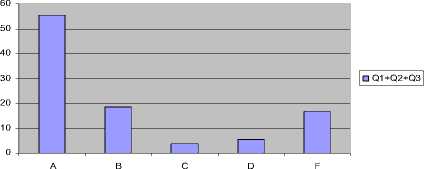
Figure 6. The average percentage for the final exam
TABLE 3
THE FINAL EXAM RESULT
|
Q1 |
Q2 |
Q3 |
|
|
A |
38.9% |
55.6% |
72.2% |
|
B |
33.3% |
22.2% |
0.00% |
|
C |
55.6% |
0.00% |
55.6% |
|
D |
55.6% |
55.6% |
55.6% |
|
F |
16.7% |
16.7% |
16.7% |
Table 5 shows the average percentage of students for both methods and as it clear the difference between the results set in the range (13% - 0.1%).
TABLE 5
THE RESULT OF THE BOTH MOETHODS
A B C D F
Self-
rating Final
68.5%
14.8%
0.0%
0.0%
16.6%
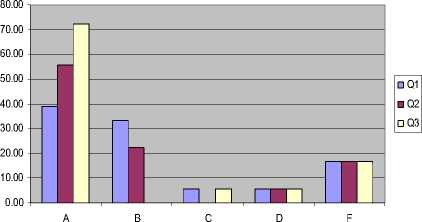
Figure 5. The final exam result
exam
55.5%
18.5%
3.70%
5.60%
16.7%

Average of student evaluated
Average of teacher evalueted
Figure 7. The result of the both methods
TABLE 4
THE AVERAGE PERCENTAGE FOR THE FINAL EXAM
|
Q1+Q2+Q3/3 |
|
|
A |
55.5% |
|
B |
18.5% |
|
C |
3.7% |
|
D |
5.56% |
|
F |
16.7% |
-
IX. 4. Conclusion
The aim of educational development is to ensure that the curriculum delivers the knowledge and skills required by the community. There are no firm rules for developing curriculum. However, in this paper, we provide some guidelines for curriculum developers concerning the kind of curriculum that deals with the economic environment. Also, we recommend establishing some type of agreement between economic organizations and higher education in order to provide students with a chance for practical learning. As a result, economic organizations may later choose to employ gifted and talented students in order to make use of their creative ideas.
Список литературы Developing E-Business Strategies Curriculum Case Study in the Information Systems Department
- Final Report, in Int. Workshop on Curriculum Develop. in Tech. and Vocational Educ., Turin, Italy, 1993.
- S. Davis, K. Siau and K. Dhenuvakonda, “A fit-gap analysis of E-Business curricula vs. industry needs, In Communications of the ACM, vol. 46, no. 12, pp. 167–177, 2003.
- W. Spady, Outcome-based Education: Critical Issues and Answers, Arlington: American Association of School Administrators, 1994.
- Feng. Li, What Is E-Business?: How the Internet Transforms Organizations, Blackwell Oxford, UK. 2007.
- “Prof. Feng Li”, ebusiness@newcastle, Available: http://www.ebusiness-newcastle.com/about/people/li/book.php
- C. Meyer and T.B. Jones, Promoting Active Learning: Strategies for the College Classroom. San Francisco: Jossey-Bass, 1993.
- S. Sajjad, “Effective teaching methods at higher education level”, Unpublished. Available: http://www.wfate.org/papers/Research_paper_Teaching_methods.pdf
- Mark Wall , “The case study method and management learning: making the most of a strong story telling tradition in emergency services management education”, The Australian Journal of Emergency Management, vol. 21 no. 2, pp. 11–16, 2006.


